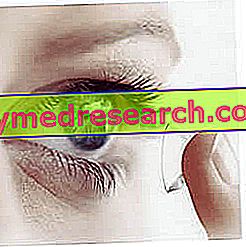What are Contact Lenses?
Contact lenses are medical devices that are applied to the ocular surface for therapeutic or aesthetic reasons. Once positioned, they adhere to the tear film that covers the front of the eye; when the eyelid blinks, it passes over the contact lens, inducing a slight movement of the same that allows the tears to bring the oxygen and lubrication necessary to the underlying cornea.

Often, these devices are chosen for aesthetic reasons, but they can also have very practical advantages in certain sports or professional situations, in which the glasses could be damaged or prevent the adequate use of protective devices. Contact lenses can also be used to treat certain eye diseases. For example, scleral lenses can correct anisometropia (inequality in the power of refraction between the two eyes) and the irregular curvature of the corneal surface in the case of keratoconus.
What to know before buying them
Contact lenses are medical devices that require special care and attention. Most people are able to wear contact lenses, while others cannot tolerate them due to their susceptibility to eye infections or a particular hypersensitivity.
If you decide to use contact lenses, the first step is to consult an ophthalmologist for a thorough examination. All contact lenses require a valid medical prescription, prepared according to an individual protocol. It is important to follow a regular follow-up program, as recommended by your doctor (indicatively after a week, a month and six months, and then once a year). Respecting the advice on cleaning, disinfection and storage mode avoids the risk of potentially dangerous vision complications. Contact lenses should not, as a rule, be worn for more than a certain number of hours per day (this depends on the characteristics of the lens and on what is specified by the doctor) and should be removed before sleeping.
Contact Lenses vs. Glasses
For many people, contact lenses offer flexibility and convenience. When compared with glasses, they provide better peripheral vision: they move with the eye and allow you to see a natural field of view. Furthermore, they do not have structures that hinder vision and significantly reduce distortions. Contact lenses do not tarnish and do not collect moisture, such as rain, snow or sweat; this makes them ideal for sports and other outdoor activities.
Types of contact lenses
Different contact lenses are available to satisfy a variety of needs and preferences, as well as a specific therapeutic regimen. These devices vary in material (rigid or soft), size (corneal, scleral, etc.), mode of wear (daily or long-term) and relative duration of application [conventional (annual replacement) and "disposable" (daily replacement or monthly)].
Based on the materials with which they are made, it is possible to distinguish two general categories of contact lenses: soft and rigid.
Soft contact lenses
Soft contact lenses are made of flexible hydroxyethylmethacrylate polymers (HEMA), silicone and other similar materials. These polymeric components are hydrophilic (composed of a maximum of 80% of water) and guarantee a good permeability to oxygen and wettability of the lens, thus offering a better general comfort.
Soft contact lenses are the easiest to handle and wear, but they cannot give the best refractive result. These adapt to the shape of the eye and tend to stay well in place, so they are a good choice if you participate in a sport or lead an active life. Thanks to their structure, they are comfortable a short distance from the system and can be worn for longer periods than rigid contact lenses. Some disadvantages include a shorter life span and an inability to correct some vision defects. New materials for soft lenses (silicone-hydrogel) have better oxygen permeability; however, some factors can influence the comfort of these devices: they are slightly more rigid and the surface of the lens can be hydrophobic, therefore less "wettable".
Soft contact lenses are available in different versions, such as:
- Disposable soft contact lenses. Soft contact lenses are generally the least expensive option. They require frequent replacement and can be worn for the prescribed period (for example from 7 to 30 days), before being thrown away. Disposable soft contact lenses are not only convenient, but they eliminate many of the concerns associated with prolonged use, such as eye infections. When removing them, be sure to clean them properly before applying them again.
- Soft contact lenses for prolonged use. Soft lenses for prolonged use have been designed to be worn for long periods of time (about seven days) without the need for removal and cleaning. These lenses are made of silicone hydrogel, a material that allows oxygen to pass six times higher than disposable lenses. Soft contact lenses for prolonged use can be worn during sleep, but must be removed at least once a week to undergo thorough cleaning and disinfection. They are advised less frequently, because, although they are approved for prolonged use, the risk of corneal abrasion and infection increases with night use of any contact lens.
- "Disposable" soft contact lenses . The disposable lenses are probably the most expensive, but also the most comfortable and easy to maintain: they are used at the time of replacement and then they are thrown away. These are removed and replaced with a new pair of lenses on a daily, weekly or monthly basis. The use of disposable devices could be considered if contact lenses are worn only occasionally.
Rigid contact lenses
Rigid contact lenses are made of glassy polymers and other materials, such as silicone or fluoropolymers. These devices may be more difficult to apply and remove, but they can correct most vision problems; they are also durable and durable. In particular, rigid contact lenses can represent the best choice in case of astigmatism or myopia and very high hypermetropia, as they allow a superior vision compared to a soft contact lens. Furthermore, they are indicated when a person suffers from allergies or tends to form protein deposits.
The rigid contact lenses are initially less comfortable than the soft ones and require an adaptation period before the wearer can get used to wearing them (up to a week). Furthermore, rigid contact lenses are more likely to slip from the center of the eye, which could lead to discomfort and blurred vision. A particular type of rigid (spherical) contact lens is able to replace the natural shape of the cornea with a new refracting surface. This means that a spherical rigid lens can correct astigmatism or corneal irregularities, such as keratoconus.
Rigid contact lenses are made of both non-oxygen permeable and permeable materials. Polymethyl methacrylate (PMMA) lenses are commonly known. One of their drawbacks is the poor passage of oxygen through the cornea, which causes a series of adverse clinical events. For this reason, PMMAs are now rarely used and are largely replaced with rigid gas-permeable contact lenses or soft contact lenses. However, this type of device still has a role in the management of severe cases of keratoconus, irregular astigmatism and some ocular surface diseases.
Rigid gas permeable contact lenses (RPG)
Rigid gas permeable contact lenses (RPGs) are similar to rigid, offer clear vision and correct most vision problems while maintaining their shape; they are also resistant and have a longer lifespan than soft contact lenses. If the prescription does not change, you can use the same pair of lenses for up to two or three years. Like rigid lenses, RPGs are not recommended for intense physical activity with a high risk of trauma. Rigid gas permeable contact lenses are often more breathable than soft, which reduces the risk of eye infections. Furthermore, they are easier to manage and offer excellent visual acuity, which makes them more suitable for astigmatic patients.
Other types of contact lenses
Depending on the vision requirements, particular types of contact lenses could be considered, such as:
- Hybrid contact lenses. Hybrid contact lenses have a rigid central disk (gas permeable) surrounded by a soft outer ring. These could be an option in case of an irregular corneal curvature (keratoconus) or if you have difficulty wearing conventional rigid lenses.
- Toric contact lenses. A toric contact lens has a different focusing power on its surface. Usually, these devices cost more than other contact lenses, but they are particularly suitable for correcting astigmatism. A toric lens must have the correct orientation to improve visual acuity and to correct the refractive defect, therefore it must have additional graphic characteristics. Some of these, in fact, have signs or incisions to facilitate the application and prevent the lens from turning away from the ideal alignment.
- Bifocal or multifocal contact lenses . Bifocal contact lenses contain different areas for near and far vision to correct presbyopia (similar to bifocal corrective glasses). These devices, soft or rigid, are comparable to prescription glasses with bifocals or progressive lenses, as they have more focal points. Multifocal contact lenses are able to correct myopia, hyperopia and astigmatism, in combination with presbyopia. Visual quality is often not as good as with monofocal contact lenses, but for some people they are a practical alternative to correct presbyopia.
- Colored contact lenses. Some contact lenses are colored for cosmetic or therapeutic purposes, to improve color perception or help compensate for color blindness. Colored lenses are available on prescription and should only be worn after an eye doctor's instructions. These devices change the color, the appearance of the eye or both. Websites often advertise colored contact lenses as if they were cosmetic products or fashion accessories, with packaging and whimsical names; however, it should be remembered that the use of contact lenses without an eye exam and a medical prescription can lead to serious eye disorders, which in extreme cases could also cause permanent loss of vision.
Important things to remember
The ophthalmologist can discuss with the patient the best methods of handling and storage, depending on the type of contact lens used. Devices that are not properly cleaned represent a potential source of infection. Worn or incorrectly applied contact lenses can abrade the ocular surface. Furthermore, a lens can deform over time and the cornea can change shape, so its degree and adaptation must be re-evaluated on a regular basis. Follow-up visits will be scheduled according to visual needs and specific eye condition.
A patient may not be a good candidate for using contact lenses in case of:
- Frequent eye infections;
- Serious allergies;
- Treatment-resistant eye dryness;
- Very dusty work environment;
- Inability to manage and treat contact lenses.
Any eye drops can interact with contact lenses, so it is best to avoid instillation, except for drops recommended by the ophthalmologist. Homemade salt solutions should not be used for contact lens cleaning, as they are associated with severe corneal infections due to possible microbial contamination.



